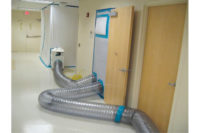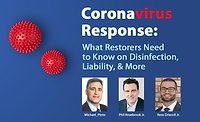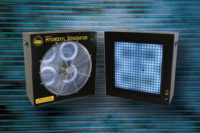Staying Safe in Medical Settings: What Contractors Need to Know








On most projects, those in the trades can face many health and safety risks during their normal daily work activities. Since many of these risks are so common, most are well recognized. These can include electrical hazards, falls, impact, chemicals, venomous snakes and insects and other hazards. Employers of those in the trades should have Injury and Illness Prevention Programs (IIPPs) that identify and communicate the hazards found in the workplace. Workers are provided with hardhats, safety shoes, gloves, quality tools and other PPE and equipment designed to minimize risks on site. But it is a challenge for employers when the workplace presents special hazards not found at a typical water or fire loss. Hospitals and other clinical settings can be just that kind of work place.
Causes for Concern?
Healthcare associated infections (HAIs) are infections that patients develop during the course of receiving healthcare treatment for other conditions. They can be caused by a wide variety of common and unusual bacteria, fungi, and viruses. These microorganisms are not selective and exposure to them is not limited to patients. People working in these environments can also be exposed. Recent news reports of Ebola outbreaks along with recurring reports of MRSA infections have many concerned. While illness associated with Ebola infections is severe, Ebola is not the only organism that causes concern in healthcare settings. Hospitals take many precautions to prevent the spread of tuberculosis (TB), staphylococcus (MRSA), clostridium difficile (C.diff) and many other infectious agents. While some of these organisms can be spread through the air, most exposures occur by touching a contaminated surface.
What do Hospitals do to Protect Us?
One of the primary systems in a hospital to control hazards is the HVAC system. By creating pressure differentials for special rooms and bringing in significant amounts of filtered fresh air while at the same time exhausting the “used” indoor air, the hospital can quickly remove airborne hazards. Placing patients with contagious diseases into negatively pressurized rooms can also help prevent the spread of airborne infectious agents to other areas of the hospital.
The HVAC system is designed to eliminate airborne contaminants. What about those organisms that are spread from surface to surface? Environmental Services (EVS) or housekeeping staff members conduct frequent, detailed cleanings of surfaces that may become contaminated. Special cleaning procedures and disinfectants are used to clean surfaces. But surfaces can become contaminated again very quickly if people are still shedding infectious agents or if all impacted surfaces are not effectively cleaned.
What can you do to Protect Yourself?
The first step to preventing injury or illness is to become aware of any potential risk. Understanding where these infectious agents may be found in your work place and how to prevent exposures is a key part of that awareness. Pre-project safety meetings are a good place to solicit support from the clinical members of a project team to ask about risk to workers. If risks are present, then the next questions to be asked are, “How can I prevent myself from being exposed?” and “What can I do so I don’t spread these organisms around the building?” Often the answer is as simple as conducting frequent hand washing. Using soap and hot water, especially before eating or performing any activity that will involve touching your mouth, nose or eyes, is easy and effective.
Thorough hand washing includes getting the hot water temperature up, rinsing your hands well, applying soap and working it all over your hands and wrists including in between each finger and especially around the fingernails. Then rinse well and dry your hands with a clean disposable towel. Use the towel to shut off the water and grab the door handle on your way out, then place the towel in the nearest trash, which is often found right next to the door.
Use of waterless hand sanitizers can also be helpful in killing organisms on your hands, but these sanitizers should be used appropriately. This means making sure that your hands are free of soil that may prevent the disinfecting agent from coming in contact with the organisms on your hand, making sure your hands are well saturated with the sanitizer and that the sanitizer remains wet long enough to achieve a complete kill. It should also be understood that some bugs are tougher than others and not all hand sanitizers are the same. For example a sanitizer that is alcohol-based may not kill spores formed by some bacteria such as C.diff.
Good hand hygiene in hospitals can include a combination of frequent hand washing in sinks using soap while using and the use hand sanitizers between washes. If you want to impress the clinical people you encounter while working in healthcare settings, let them see you applying these good hand hygiene practices frequently while you work in their area.
In some instances you may be required to wear additional personal protective equipment (PPE) such as disposable coveralls, gloves, booties and/or a respirator. If this is the case, you will need to know where and when to don the PPE. You will also need to know how to safely remove it and where to dispose of it or how to safely decontaminate it. Some facilities may prohibit workers with cuts or open wounds from working in some areas of their buildings.
In many settings vaccinations may be recommended while in others they may be required for you to work in their institution. Measles, mumps rubella, varicella-zoster, chicken pox and TB are some of the infectious diseases against which you may need to be vaccinated. Many people may already be vaccinated against some of the diseases. However some vaccines, like influenza (i.e. the flu), are seasonal and may be required annually. You should discuss the need for vaccines with your doctor.
As working in healthcare settings becomes more common, employers can update their IIPP to include identification and control of health and safety risks related to infectious agents that may be encountered. However it should be understood that each clinical environment is different. Therefore it may be important for the employer’s health and safety officer to make contact with his or her counterpart in the hospital to lay the groundwork. Together the risks can be identified, safe practices communicated and exposures prevented.
Looking for a reprint of this article?
From high-res PDFs to custom plaques, order your copy today!











